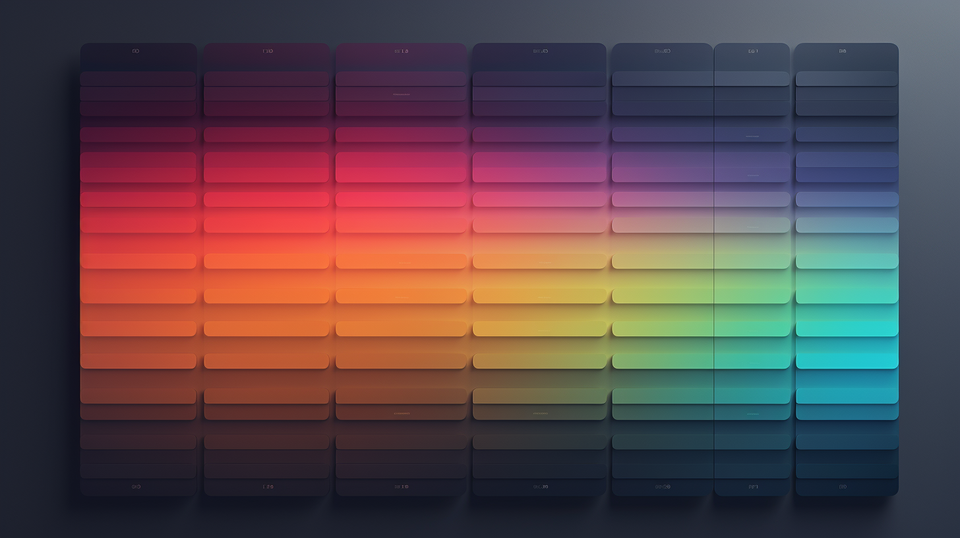Why and How AI can Craft Your Ideal Color Palette

Did you know that the human eye can perceive approximately 7 million different colors?
New AI capabilities allow anyone to effortlessly create color schemes scientifically designed to evoke specific moods and emotions.
WHY does it matter?
The core reason to use AI for generating color palettes is to efficiently explore optimal color combinations. If you have a brand, it will help you to build a strong brand identity that attracts and retains customers amid high competition.
Top 5 benefits:
- Provides data-driven insights essential for strategic color palette decisions;
- Tailors color palettes for brand memorability, distinction and value alignment;
- Crafts palettes to evoke desired emotional reactions, ensuring resonance with audiences and alignment with brand messaging goals;
- Ensures accessibility through optimization for contrast, color deficiencies, and readability;
- Accelerates color selection through automation, allowing designers to focus on creativity.
HOW
Open ChatGPT or your preferred AI assistant. Enter this prompt:
Assume the role of an expert color strategist.
Your task is to generate a comprehensive color palette guide for {your brand name}.
Present your recommendations in a table format.
Table Columns:
Color Name: Specify the name of the color (e.g., Royal Blue).
Hex Code: Include the hex code for digital applications (e.g., #4169E1).
RGB Values: Provide the RGB values for cross-platform compatibility (e.g., 65, 105, 225).
CMYK Values: Include the CMYK values for printing purposes (e.g., 100, 50, 0, 0).
Pantone Coated: Provide the Pantone Coated reference for professional print and design (e.g., 286 C).
Use Case: Describe where this color should primarily be used (e.g., Background, Text, Accents).
Emotional Tone: Explain the emotion or mood the color is intended to evoke (e.g., Calm, Energetic).
Compatibility: Suggest other colors in the palette that it pairs well with.
Contrast Ratio: Calculate the contrast ratio against the background color to ensure text readability.
Accessibility Guidelines:
Aim for a contrast ratio of at least 4.5:1 for text and 3:1 for large text.
Provide alternatives for color vision deficiencies like color blindness.
Ensure that the palette supports a high degree of readability and usability across digital and print platforms.
Guidelines for Palette Creation:
The palette should include primary, secondary, and accent colors.
Consider the psychology of colors and how they align with your brand's values and objectives.
Ensure that the palette is cohesive and versatile for various applications, including digital and print.
All color choices should meet or exceed current accessibility standards for contrast and readability.
About {your brand}:
{Provide detailed informations about your brand}
TIPS
#01. Make sure you include the following information when describing your brand:
1. Detail your brand values: Core principles guiding your brand;
2. Brand Personality: Human traits associated with your brand;
3. Product/Service Description: What your brand offers;
4. Target Audience: Details of your consumers;
5. Unique Selling Proposition: What sets your brand apart.
#02. Use the same prompt with different AI assistants. Benefits:
1. Diverse Perspectives: Different training data in each model leads to varied interpretations and more idea generation;
2. Accuracy Enhancement: Multiple models can help identify and correct potential biases or errors;
3. Comprehensive Analysis: Each model may emphasize different aspects of the prompt for a well-rounded review;
4. Cross-verification: Similar results across models can increase confidence in output accuracy;
5. Language Adaptation: Translating the prompt into different languages can provide new insights and refine meaning.
Conclusion:
Color evokes primal, personal responses that shape aesthetics, moods, identity.
Artists intuit captivating color combinations through creative vision and technical mastery.
AI rapidly analyzes millions of patterns behind effective palettes via data-driven insights.
This symbiosis empowers anyone to curate colors tailored to their aims, granting access to invaluable visual inspiration.
More than a tool, AI democratizes the principles behind optimal color use, intent, and emotion. Enjoy!
BOOK
If you're looking for a good book on colors for use in branding, I have a suggestion:
"The Designer's Dictionary of Color" by Sean Adams is a rich resource for anyone keen on delving into color's broad spectrum, with a systematic color-by-color organization aiding easy navigation. It extends beyond mere color selection by exploring the cultural, historical, and social meanings of key colors. A practical guide for designers, students, and professionals across graphic design firms, art schools, advertising agencies, and interior design companies, it opens the door to creating visually engaging branding and design projects. Available for purchase on Amazon, it's a gateway to harnessing color's full potential in various design realms.


Fusing art, design and AI to craft visionary brands.
Bridging art and innovation across illustrations, fashion, murals, tattoos and multimedia - I constantly redefine my creative frontiers.
Leveraging leading-edge AI, I create singular brand identities and strategic narratives—redefining visual experiences.
Follow me, and let`s connect ☞ https://bit.ly/linkmarcel
Questions? Reach Out via Email 📬
Keep learning, creating, and enjoy the journey!